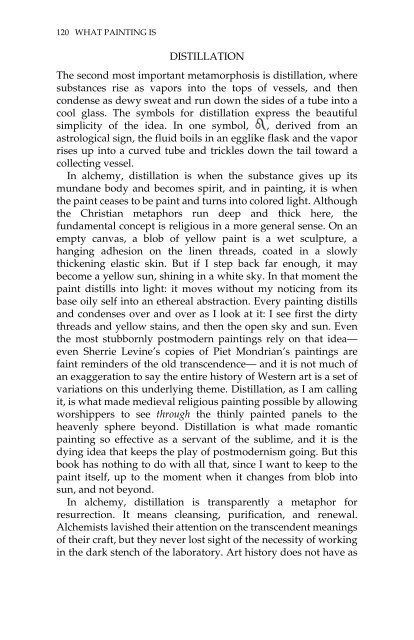What Painting Is: How to Think about Oil Painting ... - Victoria Vesna
What Painting Is: How to Think about Oil Painting ... - Victoria Vesna
What Painting Is: How to Think about Oil Painting ... - Victoria Vesna
You also want an ePaper? Increase the reach of your titles
YUMPU automatically turns print PDFs into web optimized ePapers that Google loves.
120 WHAT PAINTING IS<br />
DISTILLATION<br />
The second most important metamorphosis is distillation, where<br />
substances rise as vapors in<strong>to</strong> the <strong>to</strong>ps of vessels, and then<br />
condense as dewy sweat and run down the sides of a tube in<strong>to</strong> a<br />
cool glass. The symbols for distillation express the beautiful<br />
simplicity of the idea. In one symbol, , derived from an<br />
astrological sign, the fluid boils in an egglike flask and the vapor<br />
rises up in<strong>to</strong> a curved tube and trickles down the tail <strong>to</strong>ward a<br />
collecting vessel.<br />
In alchemy, distillation is when the substance gives up its<br />
mundane body and becomes spirit, and in painting, it is when<br />
the paint ceases <strong>to</strong> be paint and turns in<strong>to</strong> colored light. Although<br />
the Christian metaphors run deep and thick here, the<br />
fundamental concept is religious in a more general sense. On an<br />
empty canvas, a blob of yellow paint is a wet sculpture, a<br />
hanging adhesion on the linen threads, coated in a slowly<br />
thickening elastic skin. But if I step back far enough, it may<br />
become a yellow sun, shining in a white sky. In that moment the<br />
paint distills in<strong>to</strong> light: it moves without my noticing from its<br />
base oily self in<strong>to</strong> an ethereal abstraction. Every painting distills<br />
and condenses over and over as I look at it: I see first the dirty<br />
threads and yellow stains, and then the open sky and sun. Even<br />
the most stubbornly postmodern paintings rely on that idea—<br />
even Sherrie Levine’s copies of Piet Mondrian’s paintings are<br />
faint reminders of the old transcendence— and it is not much of<br />
an exaggeration <strong>to</strong> say the entire his<strong>to</strong>ry of Western art is a set of<br />
variations on this underlying theme. Distillation, as I am calling<br />
it, is what made medieval religious painting possible by allowing<br />
worshippers <strong>to</strong> see through the thinly painted panels <strong>to</strong> the<br />
heavenly sphere beyond. Distillation is what made romantic<br />
painting so effective as a servant of the sublime, and it is the<br />
dying idea that keeps the play of postmodernism going. But this<br />
book has nothing <strong>to</strong> do with all that, since I want <strong>to</strong> keep <strong>to</strong> the<br />
paint itself, up <strong>to</strong> the moment when it changes from blob in<strong>to</strong><br />
sun, and not beyond.<br />
In alchemy, distillation is transparently a metaphor for<br />
resurrection. It means cleansing, purification, and renewal.<br />
Alchemists lavished their attention on the transcendent meanings<br />
of their craft, but they never lost sight of the necessity of working<br />
in the dark stench of the labora<strong>to</strong>ry. Art his<strong>to</strong>ry does not have as


